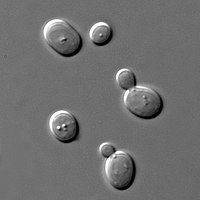
Photo from wikipedia
Four strains of bioflocculant-producing bacteria were isolated from a palm oil mill effluent (POME). The four bacterial strains were identified as Pseudomonas alcaliphila (B1), Pseudomonas oleovorans (B2), Pseudomonas chengduensis (B3),… Click to show full abstract
Four strains of bioflocculant-producing bacteria were isolated from a palm oil mill effluent (POME). The four bacterial strains were identified as Pseudomonas alcaliphila (B1), Pseudomonas oleovorans (B2), Pseudomonas chengduensis (B3), and Bacillus nitratireducens (B4) by molecular identification. Among the four bacterial strains, Bacillus nitratireducens (B4) achieved the highest flocculating activity (49.15%) towards kaolin clay suspension after eight hours of cultivation time and was selected for further studies. The optimum conditions for Eriochrome Black T (EBT) flocculation regarding initial pH, type of cation, and B4 dosage were determined to be pH 2, Ca2⁺ cations, and a dosage of 250 mL/L of nutrient broth containing B4. Under these conditions, above 90% of EBT dye removal was attained. Fourier transform infrared spectroscopic (FT-IR) analysis of the bioflocculant revealed the presence of hydroxyl, alkyl, carboxyl, and amino groups. This bioflocculant was demonstrated to possess a good flocculating activity, being a promissory, low-cost, harmless, and environmentally friendly alternative for the treatment of effluents contaminated with dyes.
Journal Title: Polymers
Year Published: 2020
Link to full text (if available)
Share on Social Media: Sign Up to like & get
recommendations!